I haven’t been ignoring my blog but I have been busy designing needlepoint hearts and making beaded butterflies. But, I have been remiss in writing about my guild’s philanthropic project, Hearts For Hospice.
Guild members (really anyone who wants to help on this project,  you do not have to be a guild member) stitch hearts; Sue and her 12 year old Grandson, Jon, make the twists (DMC #3 perle) to finish the hearts, Georgia and Sara (and sometimes we have a finishing day) finish these hearts at no cost and the hearts are donated to three (3) local Hospice Houses, one is a children’s home.
you do not have to be a guild member) stitch hearts; Sue and her 12 year old Grandson, Jon, make the twists (DMC #3 perle) to finish the hearts, Georgia and Sara (and sometimes we have a finishing day) finish these hearts at no cost and the hearts are donated to three (3) local Hospice Houses, one is a children’s home.
Maybe you saw the article in ANG NeedlePointers, Jan/Feb 2019 and May 2017; Needlepoint Now, January/February 2019, and on Facebook.
It all began when our friend Georgia went over to “The Home” at her retirement community to volunteer. They asked her if she had received her flu shot and of course she had not (doesn’t like them or maybe they don’t like her…can’t remember), so she could not volunteer. A staff member saw hearts Georgia was stitching and inquired about them and asked if she could make more. Knowing she could stitch a heart, she returned home and started making hearts and that’s how it began…one heart at a time.
Within the month she had convinced several of her friends to join her and soon it became a project and another friend, Sue Hart organized us into a philanthropic group and offered the project to our guild as an ongoing philanthropic project.
Side note: did you know that all non-for-profit organizations need a philanthropic program to qualify as a 501(3)(c)? I didn’t but it makes sense if you are a non-for-profit organization that you would do something. I know our national bylaws state that our purpose is to teach, promote and preserve the art of needlepoint but I did not know you need to have an ongoing philanthropic project.
 We have encouraged members to just try a stitch and variations. These hearts make great doodle canvases. Then if you take a picture of it you will have a permanent copy and a family will receive a lovely remembrance. We have also encouraged needlepointers to take the painted canvas they thought they couldn’t live without, but have now become less likely to finish and make a heart(s) out of the painted canvas. There are two hearts from a painted canvas in this picture.
We have encouraged members to just try a stitch and variations. These hearts make great doodle canvases. Then if you take a picture of it you will have a permanent copy and a family will receive a lovely remembrance. We have also encouraged needlepointers to take the painted canvas they thought they couldn’t live without, but have now become less likely to finish and make a heart(s) out of the painted canvas. There are two hearts from a painted canvas in this picture.
Barbara Richardson; a friend of GKCNG members and past president of ANG adapted her heart design for us to use. We use it to teach groups of needlepointers how to start and some first time needlepointers. We even have a class that shows you how to finish these hearts.
 Several months ago Colour Complements: https://colourcomplements.com/ embroidery threads sent me samples to hand out to guild members I had
Several months ago Colour Complements: https://colourcomplements.com/ embroidery threads sent me samples to hand out to guild members I had  several left over and so I stitched hearts with them and sent pictures to Colour Complements. The owner contacted me and I have designed a couple hearts for her use (soon to appear on her website, I think).
several left over and so I stitched hearts with them and sent pictures to Colour Complements. The owner contacted me and I have designed a couple hearts for her use (soon to appear on her website, I think).
 This summer, one of the bead groups I belong to posted a beaded butterfly and I stitched those for some hearts. I asked permission of the designer, Patricia Parker to stitch them for other hearts and she gladly gave her permission. So guild members that request butterflies for their hearts will get one and I have made several for the two finishers to use at their discretion.
This summer, one of the bead groups I belong to posted a beaded butterfly and I stitched those for some hearts. I asked permission of the designer, Patricia Parker to stitch them for other hearts and she gladly gave her permission. So guild members that request butterflies for their hearts will get one and I have made several for the two finishers to use at their discretion.
We (I use this term loosely, because I am but a small part of this endeavor) have been doing this for the last four years and have completed over 1400 hearts. We have received hearts from 26 states and 2 countries. There are at least three other guilds that we know about who have started their own program.
If you or your guild would like the information, contact Sue Hart at  Heartsforhospicegkcng@gmail.com
Heartsforhospicegkcng@gmail.com
If you have any #5 or #3 perle cotton or #12-16 Kreinik Braid (Ribbons work too), or any thread suitable for cording laying around, it needs to be skeins not cut. And you don’t know what to do with it , Hearts For Hospice would be happy to use it. Just contact me or Sue Hart.
I have designed another heart in two colorways for our Hearts For Hospice  program and I will PDF you the instructions for free These hearts used Colour Complements Overdye, DMC #5 perle cotton, and Kreinik #12 braid but any of your stash will work. All I ask is that you please stitch one for our Hearts For Hospice program and return to them. All the information to return to Hearts For Hospice are in the instructions. Thank you.
program and I will PDF you the instructions for free These hearts used Colour Complements Overdye, DMC #5 perle cotton, and Kreinik #12 braid but any of your stash will work. All I ask is that you please stitch one for our Hearts For Hospice program and return to them. All the information to return to Hearts For Hospice are in the instructions. Thank you.
Thank you for stopping by, I hope you have time to stitch today.
ttfn…sue









































 You need bobbins to roll your looooong lengths of yarn on (save bath tissue cardboards…they make good bobbins for large yearns and large amounts of yarn). So we have bobbins
You need bobbins to roll your looooong lengths of yarn on (save bath tissue cardboards…they make good bobbins for large yearns and large amounts of yarn). So we have bobbins

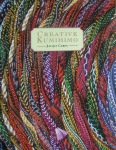 Creative Kumihimo by Jacqui Carey,
Creative Kumihimo by Jacqui Carey,

 probably never be a more than dabbler in this technique, I knew I was hooked when I had a lunch box and bag for my supplies. In my lunch box I keep a pair of working scissors, a tape measure, weights, the different disks I have and my current project. In my bag are different sized bobbins, some sample braids I have made to see patterns and the yarn for these sample braids.
probably never be a more than dabbler in this technique, I knew I was hooked when I had a lunch box and bag for my supplies. In my lunch box I keep a pair of working scissors, a tape measure, weights, the different disks I have and my current project. In my bag are different sized bobbins, some sample braids I have made to see patterns and the yarn for these sample braids.
 This is the one I finally made for gift I made last year. It is just #5 perle cotton.
This is the one I finally made for gift I made last year. It is just #5 perle cotton.











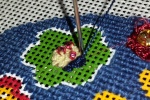
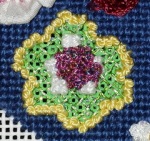



 braid and who but me is going to notice. In fact if you look at the pictures, the magenta Kreinik I used is Confetti Pink 042 and I believe this is one of the colors Kreinik is phasing out. I happen to love it and have it in every size so if I ran out I used another size. I have even been known to twist ribbon in the needle to use as braid.
braid and who but me is going to notice. In fact if you look at the pictures, the magenta Kreinik I used is Confetti Pink 042 and I believe this is one of the colors Kreinik is phasing out. I happen to love it and have it in every size so if I ran out I used another size. I have even been known to twist ribbon in the needle to use as braid.
 And since I am on the French knot making roll, why stop? I decided that since I was not found of doing satin stitch, French Knots on a Stick would do nicely for the petals of the red flowers. In case you hadn’t noticed all the red flowers are really Confetti Pink, and guess what the Needlepoint Police have not shown up at my door yet…and if they do I’m not answering the door! And yes the centers are filled with more French Knots using green Kreinik, yellow floss and pink beads.
And since I am on the French knot making roll, why stop? I decided that since I was not found of doing satin stitch, French Knots on a Stick would do nicely for the petals of the red flowers. In case you hadn’t noticed all the red flowers are really Confetti Pink, and guess what the Needlepoint Police have not shown up at my door yet…and if they do I’m not answering the door! And yes the centers are filled with more French Knots using green Kreinik, yellow floss and pink beads.










 So I took a deep breath and started the white flowers. I used Sparkle Rays for these flowers and noticed as I was pulling a thread of the
So I took a deep breath and started the white flowers. I used Sparkle Rays for these flowers and noticed as I was pulling a thread of the




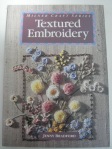









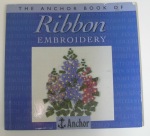
 was basically small embroidery (decorative stitches) flowers done with rayon floss. I used them to stitch on denim shirts in the 1980’s.
was basically small embroidery (decorative stitches) flowers done with rayon floss. I used them to stitch on denim shirts in the 1980’s. The Bossa Nova rose and Friends. Mary Clark and Vee Wedoo. self published, Colorado. 1980.
The Bossa Nova rose and Friends. Mary Clark and Vee Wedoo. self published, Colorado. 1980.